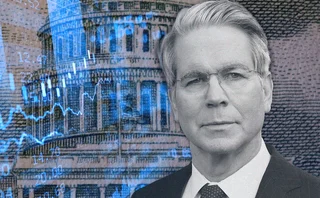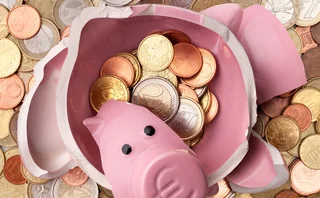
CVA study highlights scale and causes of wrong-way risk
Researchers advise including correlations both with rate level and volatility in CVA calculations

Crisis-era data on interest rate derivatives shows that wrong-way risk has a significant impact on their pricing, but the effect is almost entirely driven by the level of underlying interest rates rather than their volatility, according to forthcoming research.
Wrong-way risk arises when the exposure to a counterparty grows together with the risk of the counterparty’s default. In contrast to right-way risk, it amplifies the credit valuation adjustment (CVA) component of a derivative’s price.
The researchers – Ramzi Ben-Abdallah of the University of Quebec and HEC Montreal’s Michèle Breton and Oussama Marzouk – analysed two potential sources of wrong-way risk for over-the-counter interest rate derivatives: a correlation between the probability of counterparty default and the level of the underlying interest rate, and a correlation between the counterparty default risk and the volatility of the underlying rate.
Plugging the two correlations into the general model for pricing CVA, they found that the first “dependence” has a much larger impact on the resulting CVA number.
In the case of interest rate swaps, for example, CVA “more than doubles” for many counterparties – regardless of the maturity of the swap – when the wrong-way risk stemming from the first correlation is taken into account, while the second correlation has only a “minor” wrong-way effect, the academics write.
For interest rate caps and floors, the correlation with the interest rate level also has a larger impact on CVA than the correlation with the rate volatility.
“The correlation [with the volatility] always has a wrong-way effect on both instruments, while [the correlation with the rate] has a right-way effect on caps and a wrong-way effect on floors,” Ben-Abdallah, Breton and Marzouk write in the paper, due to be published in the Journal of Credit Risk in June.
“Interestingly, the materiality of the [volatility correlation] effect is small, especially for shorter-maturity options,” they add. “This may seem surprising since option exposures are affected by volatility. A plausible explanation is that, since CVA is an expectation, the scenarios that predominantly contribute to CVA are those in which the option is deep-in-the-money. In those scenarios, the sensitivity of the option price to the volatility is small, so that volatility has little impact on the exposure.”
Gap risk
The researchers also looked at the impact of the correlations on the CVA of collateralised interest rate swaps, writing: “Even when an interest rate swap is fully collateralised, there exists a risk that the value of the position will move significantly after the counterparty’s default but before it can be unwound or replaced. This is the so-called gap risk, that can result in a potentially signi ficant loss, particularly during turbulent periods.”
And here their findings are slightly different. The correlation between default risk and the rate volatility has a small effect on CVA, as with the other products, but the correlation between default risk and the rate level also has a small impact, with no clear tendency to always increase CVA.
Though rate volatility has only a minor effect on CVA, it should not be ignored, the researchers conclude.
“The impact of wrong-way risk is amplified when both correlations are included, especially for credit-riskier counterparties … These two sources of risk may need to be taken into account simultaneously to fairly price and hedge the CVA of an interest rate derivative position.”
The research was based on the December 5, 2008 prices of OTC interest rate derivatives and credit default swaps involving eight major US financial institutions. The academics chose that date partly because it fell during the period of significant systemic credit risk following the collapse of Lehman Brothers.
Ben-Abdallah, Breton and Marzouk computed CVA for each counterparty in four scenarios: in the first, default risk is assumed to be independent from all sources of market risk; in the other three, either or both correlations exist.
For comparison purposes, they also calculated the potential future loss – defined as the ninety-fifth percentile of the distribution of exposure, conditional on default – in each case.
Editing by Olesya Dmitracova
Only users who have a paid subscription or are part of a corporate subscription are able to print or copy content.
To access these options, along with all other subscription benefits, please contact info@risk.net or view our subscription options here: http://subscriptions.risk.net/subscribe
You are currently unable to print this content. Please contact info@risk.net to find out more.
You are currently unable to copy this content. Please contact info@risk.net to find out more.
Copyright Infopro Digital Limited. All rights reserved.
As outlined in our terms and conditions, https://www.infopro-digital.com/terms-and-conditions/subscriptions/ (point 2.4), printing is limited to a single copy.
If you would like to purchase additional rights please email info@risk.net
Copyright Infopro Digital Limited. All rights reserved.
You may share this content using our article tools. As outlined in our terms and conditions, https://www.infopro-digital.com/terms-and-conditions/subscriptions/ (clause 2.4), an Authorised User may only make one copy of the materials for their own personal use. You must also comply with the restrictions in clause 2.5.
If you would like to purchase additional rights please email info@risk.net
More on Markets
Japan’s yen swaps go global
JSCC isn’t just clearing swaps, it is clearing the way for the next stage of Japan’s financial evolution
Quants tell FX dealers how to make the most of passive liquidity
Paper from HSBC and Imperial sets out when to skew pricing, and when not
How Bessent learned to stop worrying and love the T-bill
Short-dated issuance shows no signs of slowing. Some fear it could end badly.
Hawkish RBA comments wrong-foot Aussie dollar rates traders
Governor Bullock’s unexpected rate hike talk led to stop-outs and losses
Hedge fund holdouts boost euro steepener bets into year-end
After some investors took profits in September, those that stayed in the trade are now doubling down
Hong Kong tech stocks flirt with peak vega on structured boom
Note issuers sell vol to flatten exposures as Alibaba, BYD, Tencent zig-zag lower
Dutch pensions weigh hedge unwinds ahead of transition
As January 1 nears, Dutch pension funds consider unwind timing to avoid rush to the exit in thin year-end liquidity
Dealer views mixed over future of profitable EM FX carry trade
Emerging market FX carry trades have generated 7.5% returns since April, but dealers question longevity







